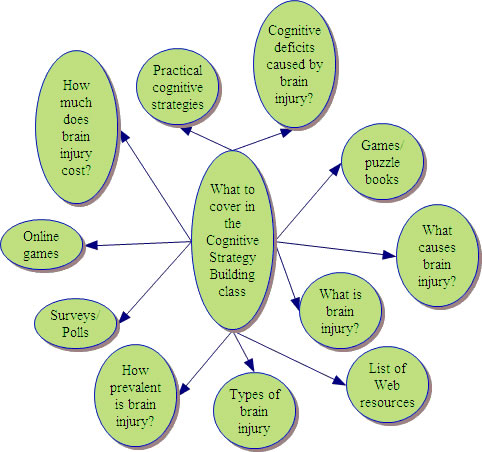Brainstorming is a very powerful cognitive strategy that can be used in a variety of areas, e.g.:
- Writing
- Problem-solving
- Decision making
- Organization
Brainstorming was developed in the 1940s and was initially used in business as a way to stimulate creativity among individuals within a group or team. Although traditionally used with groups, it can also be used by individuals to identify possibilities or options associated with a particular issue. Doing a simple online search will reveal that there are many different brainstorming techniques. In fact, many of you may already be well-versed in its practical application.
That being said, I would like to present a brainstorming technique that, while not unique, has proven to be effective for individuals living with brain injury. I applied this technique as I created my online Cognitive Strategy Building class offered through Coastline Community College’s Acquired Brain Injury Program. I used a concept-mapping program (Inspiration) to visually represent my brainstormed ideas.
Brainstorming technique—phase one
- Use either a sheet of paper or a computer program like Inspiration.
- In the center of the page, identify the issue, question, etc. to be addressed during this brainstorm session (e.g., “What to cover in the Cognitive Strategy Building class”).
- Set a timer for 10 minutes.
- Write down as many ideas related to the topic as you can before the timer goes off, following these guidelines:
- Write down all ideas that come to mind, no matter how ridiculous or unrealistic.
- Don’t edit while brainstorming. For instance, don’t correct spelling or analyze ideas during this 10-minute brainstorming phase.
- When the timer goes off, review the information you came up with during the brainstorm session.
Let’s take a look at what I came up with during my initial brainstorming session regarding what to cover in the Cognitive Strategy Building class:

As you can see, I came up with quite a few ideas in my initial 10-minute session. I didn’t stop myself, even though I wasn’t sure I would be able to cover all the general topics listed or even whether they were the right topics. What I did do was ask myself to think about everything I would like to do in the class, regardless of how realistic it might be. Once I completed the ten minutes, I went back and corrected all my spelling (so it would look nice for you), and then considered the various ideas that came to mind.
Potential challenges to brainstorming—phase one
Individuals living with brain injuries may experience some difficulties with this technique. If you are a professional working with such a client, you’ll find some helpful ideas below. If you are the person with cognitive challenges, see if you recognize some of these issues in yourself and try out some of these strategies:
| Challenge | Strategy |
|---|---|
| The 10-minute limit may cause anxiety. | Remember that the 10-minute limit is there to provide a quick opportunity to complete an initial attempt at the task. It’s not meant to be the “whole thing,” so there’s no pressure. |
| Some individuals may perseverate ((To perseverate is to persistently or uncontrollably repeat a thought, utterance (spoken word or phrase), or action)) on one idea and may not be able to let go of that idea in order to brainstorm other possibilities. | Set a second timer that goes off every 90 seconds as a prompt to move on to a different idea.. |
| Others may get distracted and find it hard to maintain concentration during the 10-minute period. | Break the 10-minute session into two 5-minute sessions. |
| Some may say they don’t have any ideas. | Initiate ideas by asking questions related to the topic (e.g., if the topic is “things to do with friends,” ask, “What do other people do to socialize?”). |
| Folks with severe memory issues may get off topic because they forget the issue being addressed. | After writing each idea, refocus by reading the initial issue or question. |
We will expand on this brainstorming technique in future articles, but for now, the important thing is going through the steps to get an initial list of ideas.
Okay, now it’s your turn to try some brainstorming!
